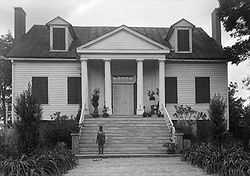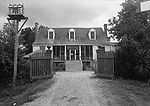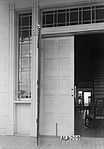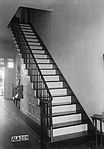Boligee Hill
From Wikipedia, the free encyclopedia
|
Boligee Hill | |
 | |
|
The house in 1936 | |
 | |
| Nearest city | Boligee, Alabama |
|---|---|
| Coordinates | 32°45′35″N 87°59′20″W / 32.75972°N 87.98889°WCoordinates: 32°45′35″N 87°59′20″W / 32.75972°N 87.98889°W |
| Built | 1840 |
| Architectural style | Other |
| Governing body | Private |
| NRHP Reference # | 82002014[1] |
| Added to NRHP | February 19, 1982 |
Boligee Hill, now known as Myrtle Hill, is a historic plantation house near Boligee, Alabama. The Boligee Hill plantation was established in 1835 by Dr. John David Means. He had migrated to Alabama from Newberry, South Carolina.[2] Dr. Means had 110 slaves according to the 1850 Greene County census.[3] The house was built in 1840.[1] It was acquired by the Hays family in 1869 and renamed Myrtle Hall for the sweet myrtle growing around it. The property was restored in 2007 by the Beeker family and renamed Myrtle Hill.[2] The house was placed on the National Register of Historic Places on February 19, 1982 due to its architectural significance.[1]
Gallery
-

Rear elevation in 1936
-

Detail of front entrance
-

Detail of staircase in entrance hall
References
- ↑ 1.0 1.1 1.2 "National Register Information System". National Register of Historic Places. National Park Service. 2008-04-15.
- ↑ 2.0 2.1 "Eutaw Historic Pilgrimage 2007". GreeneAlGenWeb. Retrieved 10 December 2008.
- ↑ "Boligee Hill Plantation". Sankofa's African Slave Genealogy. Retrieved 10 December 2008.
External links
| ||||||||||||||||||||
This article is issued from Wikipedia. The text is available under the Creative Commons Attribution/Share Alike; additional terms may apply for the media files.
